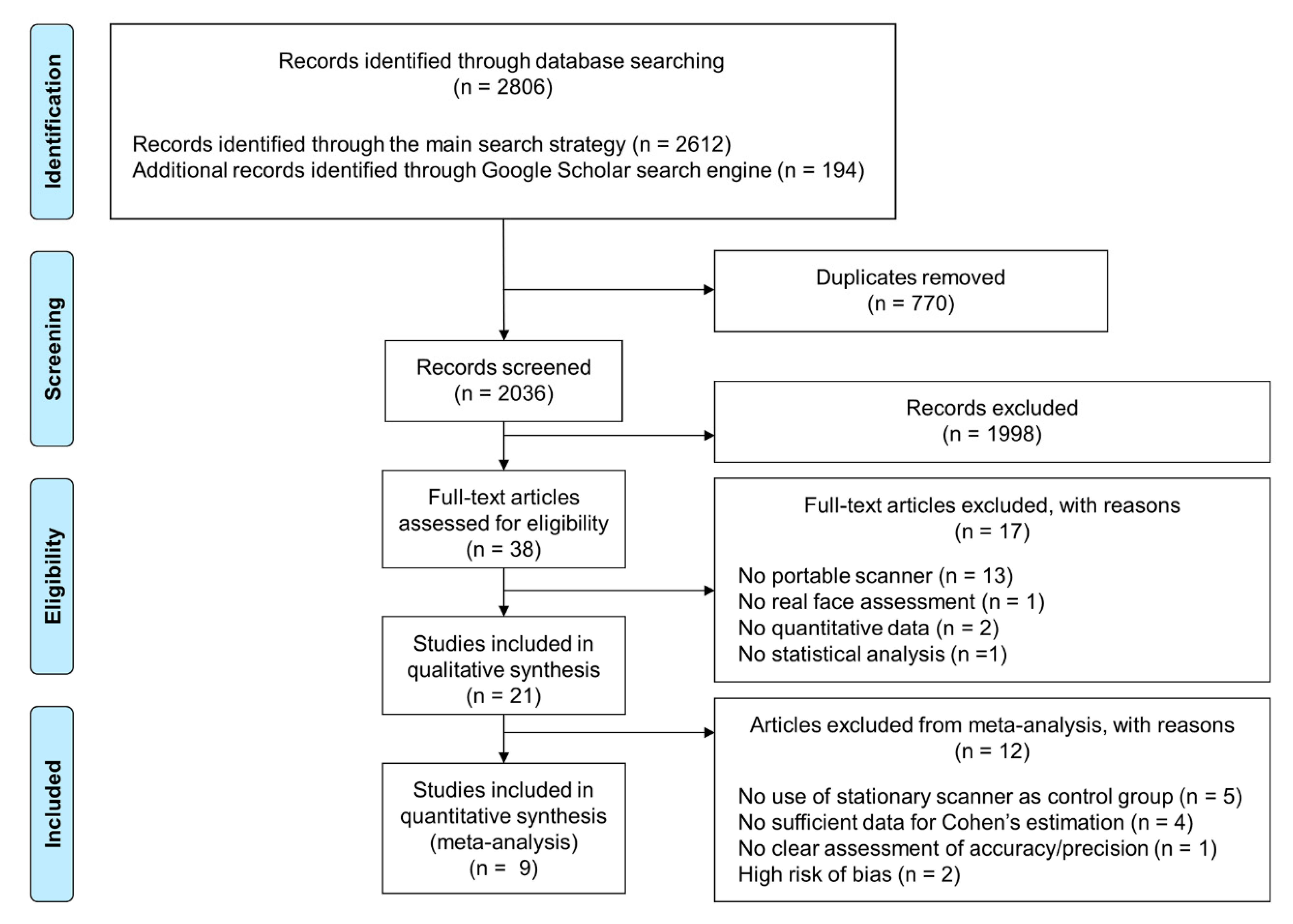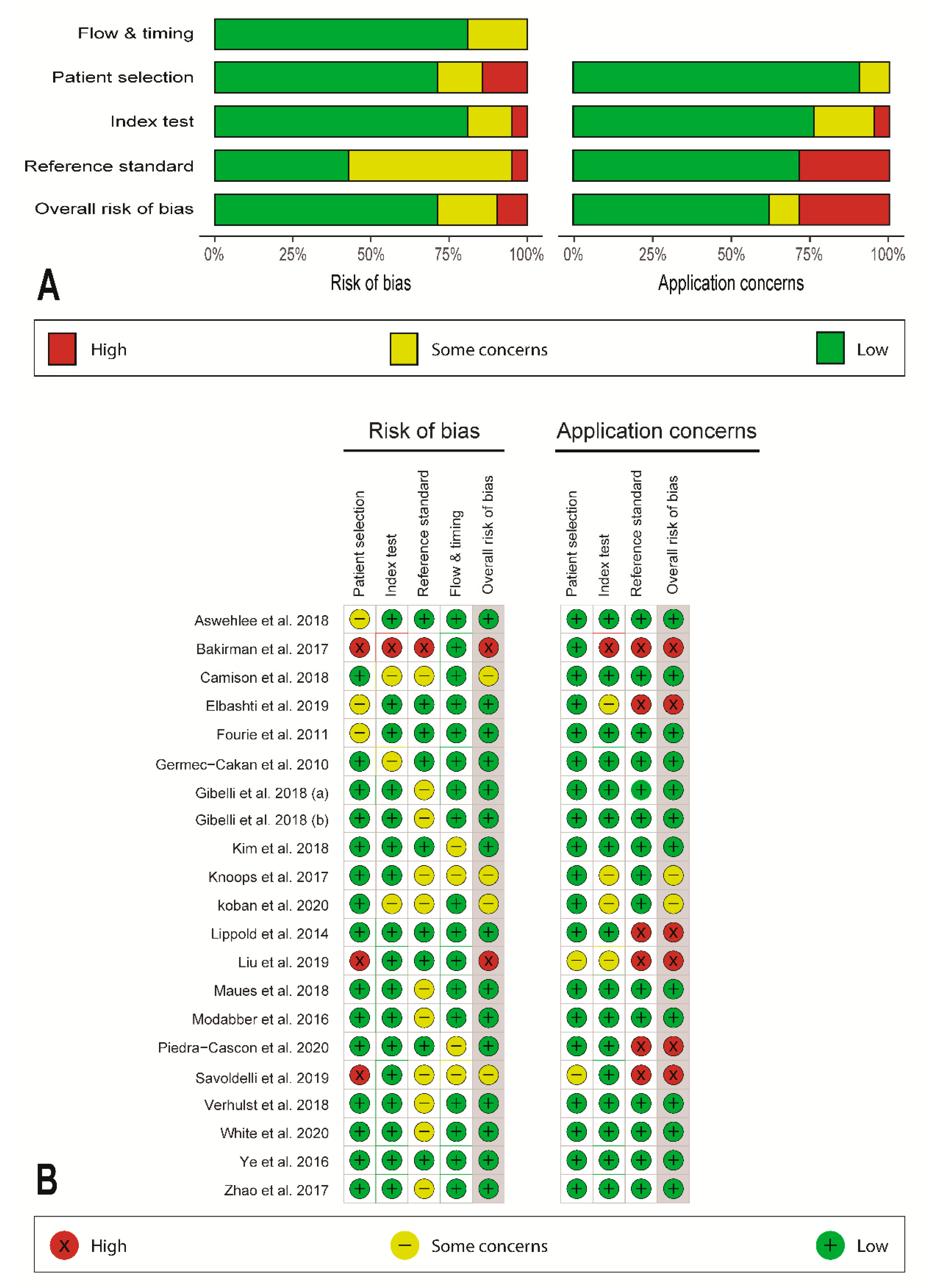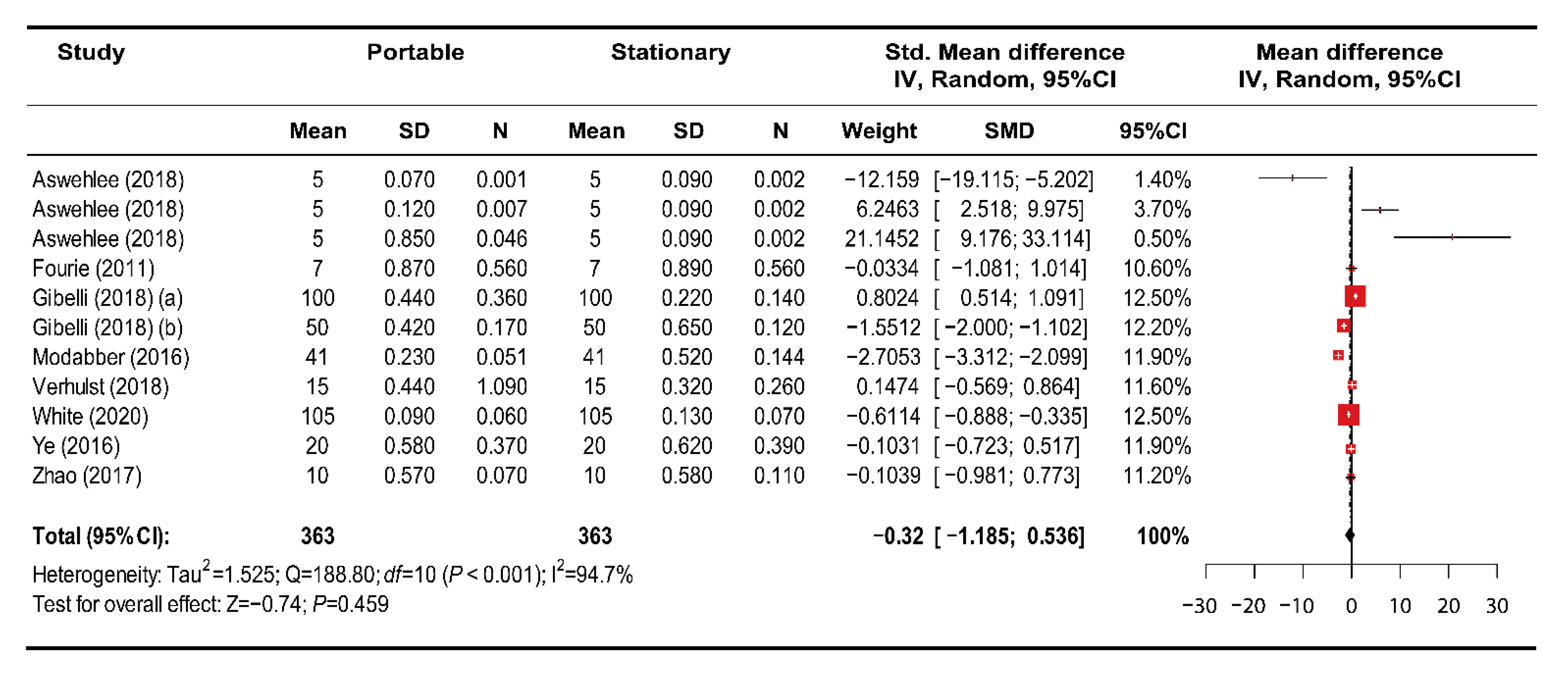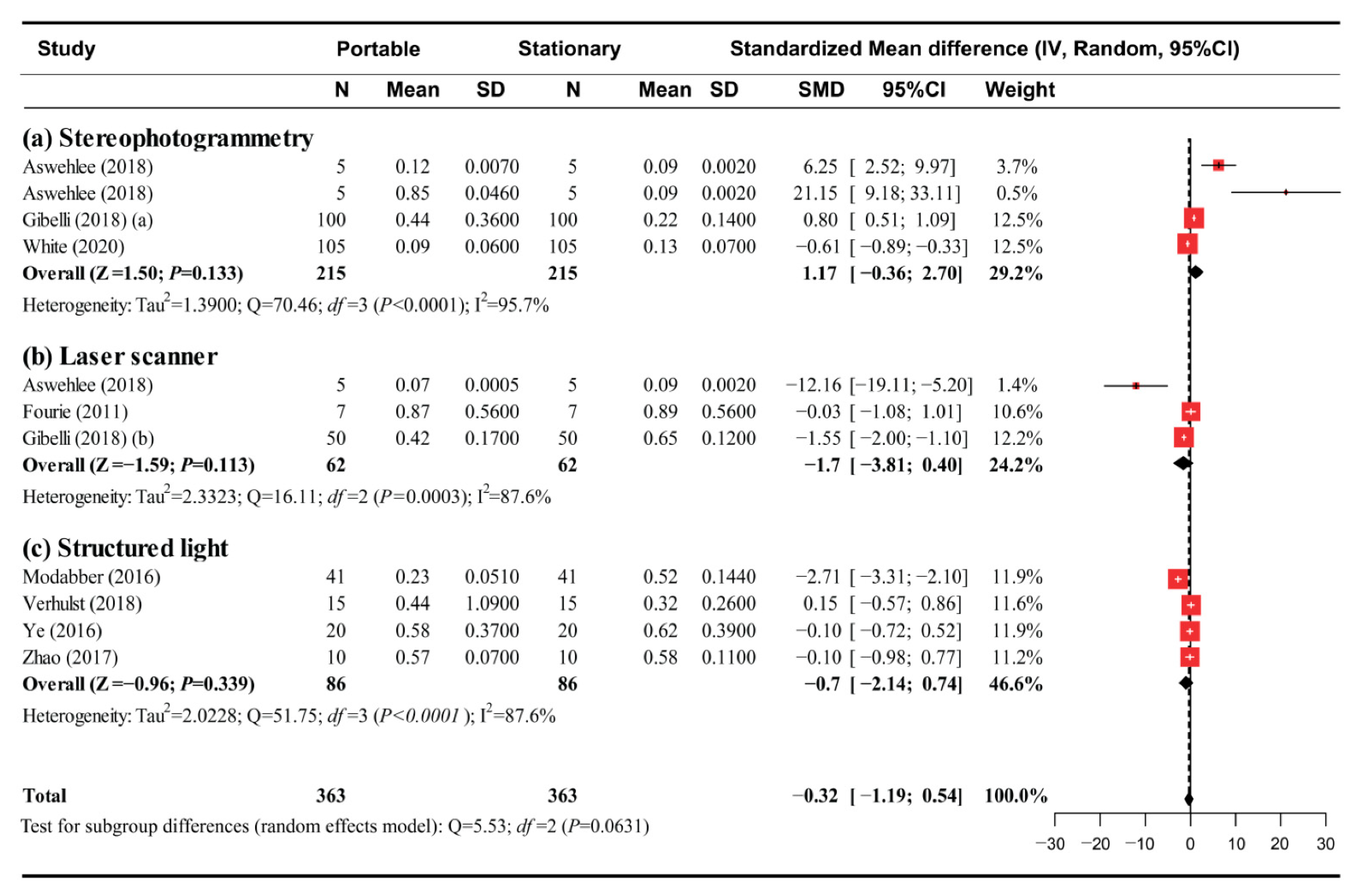Accuracy of Portable Face-Scanning Devices for Obtaining Three-Dimensional Face Models: A Systematic Review and Meta-Analysis
Abstract
1. Introduction
2. Materials and Methods
2.1. Search Strategy
2.2. Inclusion and Exclusion Criteria
2.3. Study Selection and Data Extraction
2.4. Quality Assessment
2.5. Data Analysis
2.6. Publication Bias
3. Results
3.1. Search Results
3.2. Quality Assessment and Applicability Concern
3.3. Characteristics of Included Studies
3.4. Meta-Analysis
4. Discussion
5. Conclusions
Supplementary Materials
Author Contributions
Funding
Institutional Review Board Statement
Informed Consent Statement
Data Availability Statement
Conflicts of Interest
References
- Zhao, Y.-J.; Xiong, Y.-X.; Wang, Y. Three-dimensional accuracy of facial scan for facial deformities in clinics: A new evaluation method for facial scanner accuracy. PLoS ONE 2017, 12, e0169402. [Google Scholar] [CrossRef] [PubMed]
- Launonen, A.M.; Vuollo, V.; Aarnivala, H.; Heikkinen, T.; Pirttiniemi, P.; Valkama, A.M.; Harila, V. Craniofacial asymmetry from one to three years of age: A prospective cohort study with 3d imaging. J. Clin. Med. 2019, 9, 70. [Google Scholar] [CrossRef] [PubMed]
- Amornvit, P.; Sanohkan, S. The accuracy of digital face scans obtained from 3d scanners: An in vitro study. Int. J. Environ. Res. Public Health 2019, 16, 5061. [Google Scholar] [CrossRef] [PubMed]
- Berssenbrügge, P.; Berlin, N.F.; Kebeck, G.; Runte, C.; Jung, S.; Kleinheinz, J.; Dirksen, D. 2D and 3D analysis methods of facial asymmetry in comparison. J. Cranio-Maxillofac. Surg. 2014, 42, e327–e334. [Google Scholar] [CrossRef]
- Chu, Y.; Yang, J.; Ma, S.; Ai, D.; Li, W.; Song, H.; Li, L.; Chen, D.; Chen, L.; Wang, Y. Registration and fusion quantification of augmented reality based nasal endoscopic surgery. Med. Image Anal. 2017, 42, 241–256. [Google Scholar] [CrossRef]
- Maués, C.P.R.; Casagrande, M.V.S.; Almeida, R.C.C.; Almeida, M.A.O.; Carvalho, F.A.R. Three-dimensional surface models of the facial soft tissues acquired with a low-cost scanner. Int. J. Oral Maxillofac. Surg. 2018, 47, 1219–1225. [Google Scholar] [CrossRef]
- Tzou, C.-H.; Artner, N.M.; Pona, I.; Hold, A.; Placheta, E.; Kropatsch, W.G.; Frey, M. Comparison of three-dimensional surface-imaging systems. J. Plast. Reconstr. Aesthet. Surg. 2014, 67, 489–497. [Google Scholar] [CrossRef]
- Douglas, T.S. Image processing for craniofacial landmark identification and measurement: A review of photogrammetry and cephalometry. Comput. Med. Imaging Graph. 2004, 28, 401–409. [Google Scholar] [CrossRef]
- Ngoc, V.T.N.; Tran, D.-K.; Dung, T.M.; Anh, N.V.; Nga, V.B.; Anh, L.Q.; Hanh, N.T.T.; Linh, N.P.; Quynh, H.N.; Chu, D.-T. Perceptions of dentists and non-professionals on some dental factors affecting smile aesthetics: A study from Vietnam. Int. J. Environ. Res. Public Health 2020, 17, 1638. [Google Scholar] [CrossRef]
- Plooij, J.M.; Maal, T.J.; Haers, P.; Borstlap, W.A.; Kuijpers-Jagtman, A.M.; Bergé, S.J. Digital three-dimensional image fusion processes for planning and evaluating orthodontics and orthognathic surgery. A systematic review. Int. J. Oral Maxillofac. Surg. 2011, 40, 341–352. [Google Scholar] [CrossRef]
- Aswehlee, A.M.; Elbashti, M.E.; Hattori, M.; Sumita, Y.I.; Taniguchi, H. Feasibility and accuracy of noncontact three-dimensional digitizers for geometric facial defects: An in vitro comparison. Int. J. Prosthodont. 2018, 31, 601–606. [Google Scholar] [CrossRef] [PubMed]
- Camison, L.; Bykowski, M.; Lee, W.; Carlson, J.; Roosenboom, J.; Goldstein, J.; Losee, J.; Weinberg, S.M. Validation of the Vectra H1 portable three-dimensional photogrammetry system for facial imaging. Int. J. Oral Maxillofac. Surg. 2018, 47, 403–410. [Google Scholar] [CrossRef]
- White, J.D.; Ortega-Castrillon, A.; Virgo, C.; Indencleef, K.; Hoskens, H.; Shriver, M.D.; Claes, P. Sources of variation in the 3dMDface and Vectra H1 3D facial imaging systems. Sci. Rep. 2020, 10, 4443. [Google Scholar] [CrossRef] [PubMed]
- Lavorgna, L.; Cervino, G.; Fiorillo, L.; Di Leo, G.; Troiano, G.; Ortensi, M.; Galantucci, L.M.; Cicciu, M. Reliability of a virtual prosthodontic project realized through a 2d and 3d photographic acquisition: An experimental study on the accuracy of different digital systems. Int. J. Environ. Res. Public Health 2019, 16, 5139. [Google Scholar] [CrossRef] [PubMed]
- Bakirman, T.; Gumusay, M.U.; Reis, H.C.; Selbesoglu, M.O.; Yosmaoglu, S.; Yaras, M.C.; Seker, D.Z.; Bayram, B. Comparison of low cost 3D structured light scanners for face modeling. Appl. Opt. 2017, 56, 985–992. [Google Scholar] [CrossRef]
- Gwilliam, J.R.; Cunningham, S.J.; Hutton, T. Reproducibility of soft tissue landmarks on three-dimensional facial scans. Eur. J. Orthod. 2006, 28, 408–415. [Google Scholar] [CrossRef] [PubMed]
- Koban, K.C.; Perko, P.; Etzel, L.; Li, Z.; Schenck, T.L.; Giunta, R.E. Validation of two handheld devices against a non-portable three-dimensional surface scanner and assessment of potential use for intraoperative facial imaging. J. Plast. Reconstr. Aesthet. Surg. 2020, 73, 141–148. [Google Scholar] [CrossRef]
- Elbashti, M.; Sumita, Y.; Aswehlee, A.; Seelaus, R. Smartphone application as a low-cost alternative for digitizing facial defects: Is it accurate enough for clinical application? Int. J. Prosthodont. 2019, 32, 541–543. [Google Scholar] [CrossRef]
- Cattoni, F.; Teté, G.; Calloni, A.M.; Manazza, F.; Gastaldi, G.; Capparé, P. Milled versus moulded mock-ups based on the superimposition of 3D meshes from digital oral impressions: A comparative in vitro study in the aesthetic area. BMC Oral Health 2019, 19, 230. [Google Scholar] [CrossRef]
- Zhang, J.; Liu, M.; Wang, L.; Chen, S.; Yuan, P.; Li, J.; Shen, S.G.-F.; Tang, Z.; Chen, K.-C.; Xia, J.J.; et al. Context-guided fully convolutional networks for joint craniomaxillofacial bone segmentation and landmark digitization. Med. Image Anal. 2020, 60, 101621. [Google Scholar] [CrossRef]
- Gherlone, E.; Ferrini, F.; Crespi, R.; Gastaldi, G.; Capparé, P. Digital impressions for fabrication of definitive “all-on-four” restorations. Implant. Dent. 2015, 24, 125–129. [Google Scholar] [CrossRef] [PubMed]
- Bohner, L.; Gamba, D.D.; Hanisch, M.; Marcio, B.S.; Neto, P.T.; Laganá, D.C.; Sesma, N. Accuracy of digital technologies for the scanning of facial, skeletal, and intraoral tissues: A systematic review. J. Prosthet. Dent. 2019, 121, 246–251. [Google Scholar] [CrossRef] [PubMed]
- Gibelli, D.; Dolci, C.; Cappella, A.; Sforza, C. Reliability of optical devices for three-dimensional facial anatomy description: A systematic review and meta-analysis. Int. J. Oral Maxillofac. Surg. 2020, 49, 1092–1106. [Google Scholar] [CrossRef] [PubMed]
- Volonghi, P.; Baronio, G.; Signoroni, A. 3D scanning and geometry processing techniques for customised hand orthotics: An experimental assessment. Virtual Phys. Prototyp. 2018, 13, 105–116. [Google Scholar] [CrossRef]
- Gibelli, D.; Pucciarelli, V.; Cappella, A.; Dolci, C.; Sforza, C. Are portable stereophotogrammetric devices reliable in facial imaging? A validation study of VECTRA H1 device. J. Oral Maxillofac. Surg. 2018, 76, 1772–1784. [Google Scholar] [CrossRef] [PubMed]
- Sawyer, A.R.; See, M.; Nduka, C. Quantitative analysis of normal smile with 3D stereophotogrammetry—An aid to facial reanimation. J. Plast. Reconstr. Aesthet. Surg. 2010, 63, 65–72. [Google Scholar] [CrossRef]
- Lane, C.; Harrell, J.W. Completing the 3-dimensional picture. Am. J. Orthod. Dentofac. Orthop. 2008, 133, 612–620. [Google Scholar] [CrossRef]
- Knoops, P.G.M.; Beaumont, C.A.A.; Borghi, A.; Rodriguez-Florez, N.; Breakey, R.W.; Rodgers, W.; Angullia, F.; Jeelani, N.U.O.; Schievano, S.; Dunaway, D.J. Comparison of three-dimensional scanner systems for craniomaxillofacial imaging. J. Plast. Reconstr. Aesthet. Surg. 2017, 70, 441–449. [Google Scholar] [CrossRef]
- Piedra-Cascón, W.; Meyer, M.J.; Methani, M.M.; Revilla-León, M. Accuracy (trueness and precision) of a dual-structured light facial scanner and interexaminer reliability. J. Prosthet. Dent. 2020, 124, 567–574. [Google Scholar] [CrossRef]
- Liberati, A.; Altman, D.G.; Tetzlaff, J.; Mulrow, C.; Gøtzsche, P.C.; Ioannidis, J.P.A.; Clarke, M.; Devereaux, P.J.; Kleijnen, J.; Moher, D. The PRISMA statement for reporting systematic reviews and meta-analyses of studies that evaluate health care interventions: Explanation and elaboration. J. Clin. Epidemiol. 2009, 62, e1–e34. [Google Scholar] [CrossRef]
- Whiting, P.F.; Rutjes, A.W.; Westwood, M.E.; Mallett, S.; Deeks, J.J.; Reitsma, J.B.; Leeflang, M.M.; Sterne, J.A.; Bossuyt, P.M.M.; The QUADAS-2 group. QUADAS-2: A revised tool for the quality assessment of diagnostic accuracy studies. Ann. Intern. Med. 2011, 155, 529–536. [Google Scholar] [CrossRef] [PubMed]
- McGuinness, L.A.; Higgins, J.P.T. Risk-of-bias VISualization (robvis): An R package and Shiny web app for visualizing risk-of-bias assessments. Res. Synth. Methods 2020. [Google Scholar] [CrossRef] [PubMed]
- Higgins, J.P.T.; Thompson, S.G.; Deeks, J.J.; Altman, D.G. Measuring inconsistency in meta-analyses. BMJ 2003, 327, 557–560. [Google Scholar] [CrossRef] [PubMed]
- Fourie, Z.; Damstra, J.; Gerrits, P.O.; Ren, Y. Evaluation of anthropometric accuracy and reliability using different three-dimensional scanning systems. Forensic Sci. Int. 2011, 207, 127–134. [Google Scholar] [CrossRef] [PubMed]
- Germec-Cakan, D.; Canter, H.I.; Nur, B.; Arun, T. Comparison of facial soft tissue measurements on three-dimensional images and models obtained with different methods. J. Craniofac. Surg. 2010, 21, 1393–1399. [Google Scholar] [CrossRef] [PubMed]
- Gibelli, D.; Pucciarelli, V.; Caplova, Z.; Cappella, A.; Dolci, C.; Cattaneo, C.; Sforza, C. Validation of a low-cost laser scanner device for the assessment of three-dimensional facial anatomy in living subjects. J. Cranio-Maxillofac. Surg. 2018, 46, 1493–1499. [Google Scholar] [CrossRef]
- Lippold, C.; Liu, X.; Wangdo, K.; Drerup, B.; Schreiber, K.; Kirschneck, C.; Moiseenko, T.; Danesh, G. Facial landmark localization by curvature maps and profile analysis. Head Face Med. 2014, 10, 54. [Google Scholar] [CrossRef]
- Modabber, A.; Peters, F.; Kniha, K.; Goloborodko, E.; Ghassemi, A.; Lethaus, B.; Hölzle, F.; Möhlhenrich, S.C. Evaluation of the accuracy of a mobile and a stationary system for three-dimensional facial scanning. J. Cranio-Maxillofac. Surg. 2016, 44, 1719–1724. [Google Scholar] [CrossRef]
- Verhulst, M.A.; Hol, M.; Vreeken, B.R.; Becking, A.; Ulrich, D.; Maal, T.J.J. Three-dimensional imaging of the face: A comparison between three different imaging modalities. Aesthet. Surg. J. 2018, 38, 579–585. [Google Scholar] [CrossRef]
- Ye, H.; Lv, L.; Liu, Y.; Liu, Y.; Zhou, Y. Evaluation of the accuracy, reliability, and reproducibility of two different 3d face-scanning systems. Int. J. Prosthodont. 2016, 29, 213–218. [Google Scholar] [CrossRef]
- Kim, A.J.; Gu, D.; Chandiramani, R.; Linjawi, I.; Deutsch, I.C.K.; Allareddy, V.; Masoud, M.I. Accuracy and reliability of digital craniofacial measurements using a small-format, handheld 3D camera. Orthod. Craniofac. Res. 2018, 21, 132–139. [Google Scholar] [CrossRef] [PubMed]
- Savoldelli, C.; Benat, G.; Castillo, L.; Chamorey, E.; Lutz, J.-C. Accuracy, repeatability and reproducibility of a handheld three-dimensional facial imaging device: The Vectra H1. J. Stomatol. Oral Maxillofac. Surg. 2019, 120, 289–296. [Google Scholar] [CrossRef] [PubMed]
- Liu, C.; Artopoulos, A. Validation of a low-cost portable 3-dimensional face scanner. Imaging Sci. Dent. 2019, 49, 35–43. [Google Scholar] [CrossRef] [PubMed]
- Secher, J.J.; Darvann, T.A.; Pinholt, E.M. Accuracy and reproducibility of the DAVID SLS-2 scanner in three-dimensional facial imaging. J. Cranio-Maxillofac. Surg. 2017, 45, 1662–1670. [Google Scholar] [CrossRef] [PubMed]
- Tzou, C.-H.; Frey, M. Evolution of 3D surface imaging systems in facial plastic surgery. Facial Plast. Surg. Clin. N. Am. 2011, 19, 591–602. [Google Scholar] [CrossRef]
- Flynn, M.J.; Badano, A. Image quality degradation by light scattering in display devices. J. Digit. Imaging 1999, 12, 50–59. [Google Scholar] [CrossRef][Green Version]
- Capparé, P.; Sannino, G.; Minoli, M.; Montemezzi, P.; Ferrini, F. Conventional versus digital impressions for full arch screw-retained maxillary rehabilitations: A randomized clinical trial. Int. J. Environ. Res. Public Health 2019, 16, 829. [Google Scholar] [CrossRef]
- Ferrini, F.; Sannino, G.; Chiola, C.; Capparé, P.; Gastaldi, G.; Gherlone, E.F. Influence of Intra-Oral Scanner (I.O.S.) on the marginal accuracy of CAD/CAM single crowns. Int. J. Environ. Res. Public Health 2019, 16, 544. [Google Scholar] [CrossRef]
- Massot-Campos, M.; Oliver-Codina, G. Optical sensors and methods for underwater 3D reconstruction. Sensors 2015, 15, 31525–31557. [Google Scholar] [CrossRef]
- Gevaux, L.; Adnet, C.; Séroul, P.; Clerc, R.; Trémeau, A.; Perrot, J.L.; Hébert, M. Three-dimensional maps of human skin properties on full face with shadows using 3-D hyperspectral imaging. J. Biomed. Opt. 2019, 24, 066002. [Google Scholar] [CrossRef]
- Paul, S.M.; Chamberlin, A.P.; Hatt, C.; Nayak, A.V.; Danoff, J.V. Reliability, validity, and precision of an active stereophotogrammetry system for three-dimensional evaluation of the human torso. Med. Eng. Phys. 2009, 31, 1337–1342. [Google Scholar] [CrossRef] [PubMed]
- Ozsoy, U.; Sekerci, R.; Hizay, A.; Yildirim, Y.; Uysal, H. Assessment of reproducibility and reliability of facial expressions using 3D handheld scanner. J. Cranio-Maxillofac. Surg. 2019, 47, 895–901. [Google Scholar] [CrossRef] [PubMed]
- Mai, H.-N.; Lee, D.-H. Accuracy of mobile device-compatible 3D scanners for facial digitization: Systematic review and meta-analysis. J. Med. Internet Res. 2020, 22, e22228. [Google Scholar] [CrossRef] [PubMed]





| Study Characteristics | Inclusion Criteria | Exclusion Criteria |
|---|---|---|
| Study design | Systematic reviews, randomized and nonrandomized controlled trials, cohort studies, case-control studies, cross-sectional studies | Conference papers, case reports, letters, epidemiologic studies, narrative reviews, author ideas, editorials, opinion articles |
| Participants | Human faces of any age, inanimate objects reproducing the true human face | Studies that used only mannequin heads or phantoms |
| Interventions | Stationary and porTable 3D optical scanners (e.g., stereophotogrammetry, laser, structured light) | Studies that used only 2D images, studies with no use of porTable 3D face scanners |
| Measurements | Linear distances, surface-to-surface distance, surface areas, volumes | Studies without numeric measurements |
| Outcomes measures | Reliability (accuracy) of facial measurements obtained by porTable 3D face scanners versus stationary 3D face-scanning devices | Studies where the accuracy or precision of the facial scanning could not be determined |
| Study | Scanner | No. Face | No. Landmark | Measurements | Conclusions |
|---|---|---|---|---|---|
| Aswehlee (2018) | Vivid 910, Danae 100SP, 3dMDface, Scanify | 1 IC | 3D point clouds | Surface deviation | Digitization of facial defect models using various noncontact 3D digitizers appears to be feasible and is most accurate with laser-beam, light-sectioning technology. |
| Bakirman (2017) | NA | 2 (1M, 1F) | 3D point clouds | Surface deviation | The outcome of the presented study showed that low-cost structured light scanners have great potential for 3D object modeling, including the human face. |
| Camison (2018) | 3dMDface, Vectra H1 | 26 (6M, 20F), 1 MH | 17; 3D point clouds | 136 linear distances, Surface deviation | The results indicated that 3D facial surface images acquired with the Vectra H1 system are sufficiently accurate for most clinical applications. |
| Elbashti (2019) | Vivid 910, iPhone | 1 IC | 3D point clouds | Surface deviation | The results showed that, within the limits of this study and in reference to standard computed tomography imaging, data acquisition with a smartphone for 3D modeling is not as accurate as commercially available laser scanning. |
| Fourie (2011) | Di3D, Vivid 900 | 7 cadaver heads (NA) | 15 | 21 Linear distances | Measurements recorded by the three 3D systems appeared to be both sufficiently accurate and reliable enough for research and clinical use. |
| Germec-Cakan (2010) | ZScanner 700, 3dMDface | 15 (6M, 9F) | 15 | 11 Linear distances | Laser scanning is not sensitive enough to visualize the deeper indentations, such as nostrils. Stereophotogrammetry is promising for 3D facial measurements and would be even better when color identification between mucocutaneous junctions of the lip region is achieved. |
| Gibelli (2018) (a) | Vectra M3, Vectra H1 | 50 (16M, 34F), 1 MH | 12; 3D point clouds | 15 Linear distances/12 angles/volumes/surfaces | The portable face scanning device (VECTRA H1) proved reliable for assessing linear measurements, angles, and surface areas; conversely, the influence of involuntary facial movements on volumes and root mean square (RMS) errors was higher compared with the static device. |
| Gibelli (2018) (b) | Vectra M3, Sense | 50 (10M, 40F), 1 MH | 17; 3D point clouds | 14 Linear distances/12 angles/volumes/surfaces | The low-cost laser scan device can be reliably applied to inanimate objects, but does not meet the standards for three-dimensional facial acquisition on living persons. |
| Kim (2018) | Vectra M3, Vectra H1 | 5 (NA) | 29 | 25 linear distances | The 3D handheld camera showed high accuracy and reliability in comparison with traditional models, indicating that this system may provide a useful tool in craniofacial anthropometry. |
| Knoops (2017) | 3dMDface, M4D scan, Structure Sensor | 8 (4M, 4F) | 4; 3D point clouds | Surface deviation | Clinical and technical requirements govern scanner choice, however, 3dMDface System and M4D Scan provide high-quality results. It is foreseeable that compact, handheld systems will become more popular in the near future. |
| Koban (2020) | Vectra XT, Artec Eva, Sense | 30 (15M, 15F), 1 MH | 3D point clouds | Surface deviation | The 3D surfaces captured by a professional surface scanner (Artec EVA) showed a similarly desirable accuracy for facial imaging as VECTRA XT reference images. This handheld device presents a suitable option for the objective documentation during rhinoplasty surgery. Sense 3D was unable to accurately capture complex facial surfaces and is therefore limited in its usefulness for intraoperative mobile three-dimensional surface imaging (3DSI). |
| Lippold (2014) | FastSCAN | 15 (5M, 10F) | 12 | 7 Linear distances | The three-dimensional laser-scanning method using a laser scanner (FastSCAN) allowed a reliable and accurate identification of anatomical landmarks of the face. The obtained distances between certain landmarks, such as the intercanthal distance, were largely consistent with those from manual measurements. |
| Liu (2019) | Vectra H1, Scanify | 2 (M) | 13 | 11 Linear distances | Scanify is a very low-cost device that could have clinical applications for facial imaging if imaging errors are corrected by a future software update or hardware revision. |
| Maues (2018) | Di3D, Microsoft Kinect | 10 (5M, 5F) | 10 | 7 Linear distances, Surface deviation | Kinect showed good precision and reasonable accuracy, and appears to be an interesting and promising resource for facial analysis. |
| Modabber (2016) | Artec EVA, FaceScan3D | 41 (16M, 25F) | 2 Lego brick | Surface deviation | Scanning with Artec EVA led to more accurate 3D models compared to scanning with FaceScan3D. The exactness achieved by both scanners was comparable to other scanners mentioned in literature. |
| Piedra-Cascón (2020) | Bellus Face Camera Pro | 10 (2M, 8F) | 6 | 5 Linear distances | The facial digitizing procedure evaluated produced clinically acceptable outcomes for virtual treatment planning. The inter-examiner reliability between the 2 operators was rated as excellent, suggesting that the type of facial landmark used in this study provides reproducible results among different examiners. |
| Savoldelli (2019) | Vectra H1 | 2 (1M, 1F) | 11 | 23 Linear distances | This study shows that the VECTRA H1 provides an accurate linear assessment of clinical parameters and allows the accurate analysis of craniofacial morphology. Furthermore, this device costs less and requires less space than other multi-pod devices |
| Verhulst (2018) | 3dMDface, Vectra XT, Artec Eva | 15 (6M, 9F) | 3D point clouds | Surface deviation | All three imaging devices showed high reproducibility and accuracy. Although the Artec EVA showed a significant lower reproducibility, the difference found was not clinically relevant. Therefore, using these different systems alongside each other in clinical and research settings is possible. |
| White (2020) | 3dMDface, Vectra H1 | 35 (N/A), 1MH | 19, 3D point clouds | Surface deviation | When the two camera systems were used separately to image human participants, this analysis found an upper bound of error potentially introduced by the use of the 3dMDface or VECTRA H1 camera systems, in conjunction with the MeshMonk registration toolbox, at 0.44 mm and 0.40 mm, respectively. For studies using both camera systems, this upper bound increased to 0.85 mm on average, and there were systematic differences in the representation of the eyelids, nostrils, and mouth by the two camera systems. |
| Ye (2016) | 3D CaMega, 3dMDface | 10 (5M, 5F) | 16 | 21 Linear distances | When applied in scanning and measuring human faces, the structured light scanning system and stereophotogrammetry scanning system both demonstrated high accuracy, reliability, and reproducibility. |
| Zhao (2017) | Faro, 3dMDface, FaceScan3D | 10 (NA) | 3D point clouds | Surface deviation | The 3D accuracy of different facial partitions was inconsistent; the middle face had the best performance. Although the practical accuracy of two facial scanners was lower than their nominal accuracy, they all met the requirement for oral clinic use. |
Publisher’s Note: MDPI stays neutral with regard to jurisdictional claims in published maps and institutional affiliations. |
© 2020 by the authors. Licensee MDPI, Basel, Switzerland. This article is an open access article distributed under the terms and conditions of the Creative Commons Attribution (CC BY) license (http://creativecommons.org/licenses/by/4.0/).
Share and Cite
Mai, H.-N.; Kim, J.; Choi, Y.-H.; Lee, D.-H. Accuracy of Portable Face-Scanning Devices for Obtaining Three-Dimensional Face Models: A Systematic Review and Meta-Analysis. Int. J. Environ. Res. Public Health 2021, 18, 94. https://doi.org/10.3390/ijerph18010094
Mai H-N, Kim J, Choi Y-H, Lee D-H. Accuracy of Portable Face-Scanning Devices for Obtaining Three-Dimensional Face Models: A Systematic Review and Meta-Analysis. International Journal of Environmental Research and Public Health. 2021; 18(1):94. https://doi.org/10.3390/ijerph18010094
Chicago/Turabian StyleMai, Hang-Nga, Jaeil Kim, Youn-Hee Choi, and Du-Hyeong Lee. 2021. "Accuracy of Portable Face-Scanning Devices for Obtaining Three-Dimensional Face Models: A Systematic Review and Meta-Analysis" International Journal of Environmental Research and Public Health 18, no. 1: 94. https://doi.org/10.3390/ijerph18010094
APA StyleMai, H.-N., Kim, J., Choi, Y.-H., & Lee, D.-H. (2021). Accuracy of Portable Face-Scanning Devices for Obtaining Three-Dimensional Face Models: A Systematic Review and Meta-Analysis. International Journal of Environmental Research and Public Health, 18(1), 94. https://doi.org/10.3390/ijerph18010094







